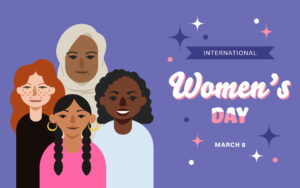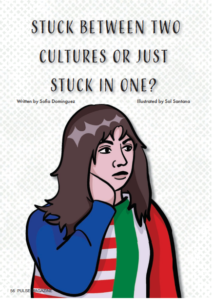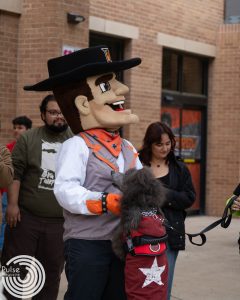When Masks are the Enemy: COVID-19’s Impact on the Deaf Community
Note from the author: Throughout this article, the word deaf will be lowercase to abide by AP style. It is important to the author that readers understand it is not their intent to offend anyone with the use of lowercase deaf.
EDINBURG, TX–While COVID-19 has changed the methods that we use to communicate with each other, it has not drastically affected the quality of our communication. However, the deaf community has taken a hit.
According to the National Association of the deaf, American Sign Language (ASL) is the language used by the deaf community to communicate with other deaf people and a selection of hearing people. ASL is a visual language that uses hand motions and facial expressions to convey information and ideas.
While signs are imperative for ASL to be effective, facial expressions are just as, if not even more, important. If someone wanted to convey the message, “I never said that to them,” it could be interpreted many different ways based on emphasis:
- I never said that to them.
The emphasis on this sentence conveys that someone else said it to them.
- I never said that to them.
The emphasis in this sentence conveys that I really didn’t say that to them.
- I never said that to them.
This sentence tells you that I told them in a way that was non-verbal.
- I never said that to them.
This sentence says that what they told you I said is not actually what I said.
- I never said that to them.
Lastly, I said that, but to someone else.
Even though these sentences were written, the message was properly conveyed due to the italics that clarify the meaning. So it is with facial expressions and signing.
During the pandemic, people have been obscuring their faces in order to stay safe. Aside from some people complaining that they cannot understand you because you are wearing a mask, they have not been a huge detriment to communication for most people. However, for the deaf community, wearing masks has impaired their ability to read expressions and even lips. Further complicating the matter are the social distancing rules and the refusal to take people’s belongings, like phones, cards, paper and pens. A TikTok creator by the username @scarlet_may.1 created a skit that shows the issues she has experienced as a deaf person in a pandemic. In the video, Scarlet is seen trying to show her phone to a ‘customer service worker’ who gets angry at her for getting too close. Next, she depicts a scene in a drive-thru where she is trying to give the worker her phone, and again the employee refuses to take the phone. To fix that, Scarlet asks them to pull down their mask so that she can read their lips, and the employee gets mad.
This video showed that while the deaf community has created methods in order to communicate with those who do not know how to sign, the pandemic canceled those methods and widened the barrier between the deaf and hearing communities. Unfortunately, this barrier has always been there.
According to Elizabeth Olatunbosun, an American Sign Language lecturer at the University of Texas Rio Grande Valley, “When I go to the store, I try to write back and forth, [but] some people won’t write back [they are speaking] and they are wearing masks. Masks are not deaf-friendly.” Olatunbosun also explained through her interpreter that she is not good at lip-reading, but hearing people will assume that deaf people are just good at it. They will insist that they do not need to write back and there is a lack of understanding.
There are some ideas about how to help deaf people communicate while wearing masks by cutting a hole in the mask and inserting clear plastic to provide a window for viewing. When asked about her opinion of these masks she said, “It doesn’t solve everything, you can see the face, but you can also see the fog.” In other words, it’s not perfect, but it’s a step in the right direction. However, international news channel France 24’s video about these masks shows that the demand exceeds supply.
In addition, Ryan Long, a member of the deaf community, said, “Unless the person already knows that I am deaf, they will attempt to communicate with me while wearing a mask. I have no idea they are even talking to me [which] leads to surprises, especially [with] law enforcement. Even after telling them I am deaf, many won’t pull down [their] masks […] then speak; they just speak louder, […] it does not work.” Long’s words indicate that these experiences are not exclusive to Olatunbosun. Any deaf person can experience these hardships.
Long has older children who are hearing and explained that he would never let them interpret for him because it is not their responsibility. But due to the masks, they have started helping him. He said, “[This] never happened pre-COVID[-19]. I forbade it. The two adults will work out a way to communicate. But COVID[-19] mask mandates or voluntary use caused me to let up a bit on this ban.”
Long, a Christian, also spoke about churches handling this situation, “All churches required masks, so it made zero sense for me to go to an in-person church because an interpreter would have to wear a mask anyways. I get 80% of the message through lip reading and 20% through sign language, which leads to disjointed communication. Online churches never captioned their services and auto-captions are terrible. I pretty much stopped going to any public gathering where there’s masks.” However, a lot of the time, people will not accommodate the deaf community because they do not know how. So what advice would the deaf community give to the hearing community to improve communication?
Olatunbosun said, “If I could give a little bit of advice to the hearing community, it’s: don’t be afraid. At work, there may be a deaf person who is looking for employment and they get shut out because they are deaf, even if they do well in the interview. [We] are seen in a negative light; so I want to encourage people to not be afraid.”
People can also educate themselves on the struggles that the deaf community faces, and work together to come up with solutions. It may be the deaf community’s struggle, but it is a hearing problem. Here are more tips on how to help:
- Learn to recognize that a person is deaf; learn the sign for deaf so that you are prepared to react accordingly.
- Respond to their notes.
- Understand that they are just as capable to do everything that you can, except hear.
- The deaf person is allowed to set the mode of communication. If they wish to write, let them. If they want to lip-read, let them. Accommodation is not about what makes the abled comfortable but letting those who need accommodations succeed.








